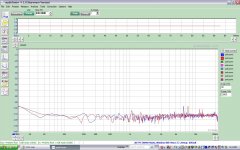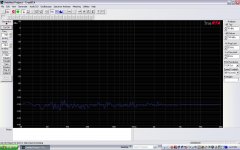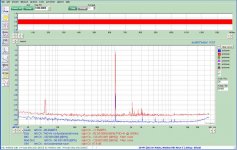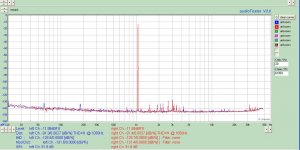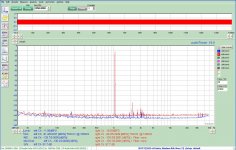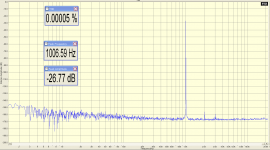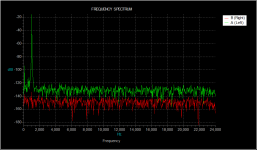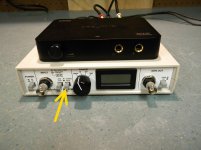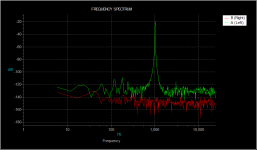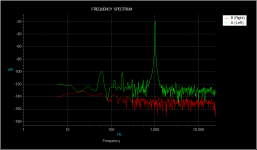That one looks generally fine, I would expect a few spikes, they are quite a way down -90db....please bear in mind, as I have found out, there be dragons down there!
This is more what I would expect. It seems that I can't do the calibration procedure unless I'm logged in as an administrator. This is TrueRTA. I paid for it to get the 1/24th octave resolution. The funny thing is that the Behringer is only rated for -98dB. I'm getting -110.
Attachments
What about this Behringer F Control FCA202?
Behringer: F-CONTROL AUDIO FCA202
S/N is only rated for 100dB, but probably better in real life.
http://www.behringer.com/assets/FCA202_P0451_S_EN.pdf
I think this one is even better:
http://www.americanmusical.com/Item--i-FOC-SCAR82I2-LIST
Behringer: F-CONTROL AUDIO FCA202
S/N is only rated for 100dB, but probably better in real life.
http://www.behringer.com/assets/FCA202_P0451_S_EN.pdf
I think this one is even better:
http://www.americanmusical.com/Item--i-FOC-SCAR82I2-LIST
Last edited:
This one also looks good:
Echo AudioFire4 Portable FireWire Audio Interface at AMS
114dB dynamic range or so.
Has anyone thought to make their own ADC/DAC? I mean, this IS DIY isn't it? It seems to me that unless I have an ADC/DAC with vanishingly low distortion, then all of my measurements will be off by what ever the ADC/DAC produces? Typical THD for these commercial devices seems to be around 0.002% or so for line level in/out.
Echo AudioFire4 Portable FireWire Audio Interface at AMS
114dB dynamic range or so.
Has anyone thought to make their own ADC/DAC? I mean, this IS DIY isn't it? It seems to me that unless I have an ADC/DAC with vanishingly low distortion, then all of my measurements will be off by what ever the ADC/DAC produces? Typical THD for these commercial devices seems to be around 0.002% or so for line level in/out.
You have no harmonics of the mains frequency. This is unusually good, excellent even. From what I have seen posted the odd harmonics are very difficult to push below the noise floor.
There is a strong 60Hz component getting through. I think you need to try and trace how this is getting in.
There is a strong 60Hz component getting through. I think you need to try and trace how this is getting in.
It is being introduced in the interface as 60Hz is below -130dBfs in loop-back mode.
I found the problem. I was using a wall wort to power the interface. It's output was floating, so I grounded the neg side. Now it is better.
I found the problem. I was using a wall wort to power the interface. It's output was floating, so I grounded the neg side. Now it is better.
Attachments
Last edited:
I'm still trying to trace down the artifacts between 2 and 4KHz. there is a strong one at 3KHz Even in cable loop-back mode they are there. I suspect it is radiated interference.
dirkwright, you may be seeing something similar.
dirkwright, you may be seeing something similar.
Just for kicks and giggles shut off everything you don't need on in the room. I've seen livhts and other powersupplies inject noise on the mains.
I've done it before, but I'll try it again tomorrow morning when everyone else is asleep.
I did finally get rid of an annoying burst at 18-20KHz. The florescent lamp ballast for the lamp fixture in the den finally died and I had to replace it.
I did finally get rid of an annoying burst at 18-20KHz. The florescent lamp ballast for the lamp fixture in the den finally died and I had to replace it.
Hi Pete,
Any thoughts on the scope shots I posted? Apart from changing the op-amp I'm out of ideas, any suggestions much appreciated.
thanks,
Andrew
Any thoughts on the scope shots I posted? Apart from changing the op-amp I'm out of ideas, any suggestions much appreciated.
thanks,
Andrew
What about using one of TI's PCM4222EVM boards with a super low distortion oscillator? I can't figure out how to get an AES signal into the computer though.
thread for DIY ADC is here:
http://www.diyaudio.com/forums/equi...ject-audio-measurements-tool.html#post2072409
Super low distortion oscillator is here:
http://www.diyaudio.com/forums/equipment-tools/205304-low-distortion-audio-range-oscillator.html
thread for DIY ADC is here:
http://www.diyaudio.com/forums/equi...ject-audio-measurements-tool.html#post2072409
Super low distortion oscillator is here:
http://www.diyaudio.com/forums/equipment-tools/205304-low-distortion-audio-range-oscillator.html
Attachments
Got my pmillett box all put together. Here it is hooked up to Visual Analyzer. This is through an M-Audio Delta 1010. Right channel in Red with nothing plugged into the Delta 1010 input jack. Left channel in Green with pmillett box box in loopback using my oscilloscope probes and just hooking the ends together in a loopback fashion. I am getting 8v RMS out of GEN OUT. I can switch the outputs and inputs on the Delta 1010 to either +4 or -10 dB. You can see the 60 hz bump. I did put some copper shielding tape on the insides of the pmillett box. I will make a better loopback cable and see what that does. Will also play with possible electrical interference devices near by.
Attachments
Got my pmillett box all put together. Here it is hooked up to Visual Analyzer. This is through an M-Audio Delta 1010. Right channel in Red with nothing plugged into the Delta 1010 input jack. Left channel in Green with pmillett box box in loopback using my oscilloscope probes and just hooking the ends together in a loopback fashion. I am getting 8v RMS out of GEN OUT. I can switch the outputs and inputs on the Delta 1010 to either +4 or -10 dB. You can see the 60 hz bump. I did put some copper shielding tape on the insides of the pmillett box. I will make a better loopback cable and see what that does. Will also play with possible electrical interference devices near by.
You don't need loop back cables to test your new Sound Card Interface. Just push the "GenMon" button. Switch SW3 (GenMon) connects the Generator Output directly to the Sound Card Interface Input (and disconnects the external inputs).
Attachments
No change in the plot with everything shout off that I could (heat pump, refrigerators etc still on, but were not active when I ran the test).
If I turn off the output of the sound card and run the scan, the interference is worse. This makes me suspect it is coming from either the computer or the sound card.
If I turn off the output of the sound card and run the scan, the interference is worse. This makes me suspect it is coming from either the computer or the sound card.
It is being introduced in the interface as 60Hz is below -130dBfs in loop-back mode.
I found the problem. I was using a wall wort to power the interface. It's output was floating, so I grounded the neg side. Now it is better.
TheGimp So you are grounding the negative from your wall wort to the negative plane on Pete's board? I'm using a switching 5v wall wort but I have quite a 60 Hz bump too.
Yikes! OK here is image one powered via USB and image two powered by a switching wall wort (with a long cord from wall wort to millett box) Could it just be picking up that much 60 Hz because the cord is long and not shielded? USB power looks like the clear winner here
Attachments
- Home
- Design & Build
- Equipment & Tools
- Test & Measurement interface for Soundcard
